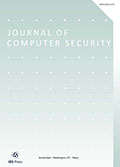Authors: Hu, Qinwen | Asghar, Muhammad Rizwan | Brownlee, Nevil
Article Type:
Research Article
Abstract:
HTTPS refers to an application-specific implementation that runs HyperText Transfer Protocol (HTTP) on top of Secure Socket Layer (SSL) or Transport Layer Security (TLS). HTTPS is used to provide encrypted communication and secure identification of web servers and clients, for different purposes such as online banking and e-commerce. However, many HTTPS vulnerabilities have been disclosed in recent years. Although many studies have pointed out that these vulnerabilities can lead to serious consequences, domain administrators seem to ignore them. In this study, we evaluate the HTTPS security level of Alexa’s top 1 million domains from two perspectives. First, we explore which
…popular sites are still affected by those well-known security issues. Our results show that less than 0.1% of HTTPS-enabled servers in the measured domains are still vulnerable to known attacks including Rivest Cipher 4 (RC4), Compression Ratio Info-Leak Mass Exploitation (CRIME), Padding Oracle On Downgraded Legacy Encryption (POODLE), Factoring RSA Export Keys (FREAK), Logjam, and Decrypting Rivest–Shamir–Adleman (RSA) using Obsolete and Weakened eNcryption (DROWN). Second, we assess the security level of the digital certificates used by each measured HTTPS domain. Our results highlight that less than 0.52% domains use the expired certificate, 0.42% HTTPS certificates contain different hostnames, and 2.59% HTTPS domains use a self-signed certificate. The domains we investigate in our study cover 5 regions (including ARIN, RIPE NCC, APNIC, LACNIC, and AFRINIC) and 61 different categories such as online shopping websites, banking websites, educational websites, and government websites. Although our results show that the problem still exists, we find that changes have been taking place when HTTPS vulnerabilities were discovered. Through this three-year study, we found that more attention has been paid to the use and configuration of HTTPS. For example, more and more domains begin to enable the HTTPS protocol to ensure a secure communication channel between users and websites. From the first measurement, we observed that many domains are still using TLS 1.0 and 1.1, SSL 2.0, and SSL 3.0 protocols to support user clients that use outdated systems. As the previous studies revealed security risks of using these protocols, in the subsequent studies, we found that the majority of domains updated their TLS protocol on time. Our 2020 results suggest that most HTTPS domains use the TLS 1.2 protocol and show that some HTTPS domains are still vulnerable to the existing known attacks. As academics and industry professionals continue to disclose attacks against HTTPS and recommend the secure configuration of HTTPS, we found that the number of vulnerable domain is gradually decreasing every year.
Show more
Keywords: HTTPS, TLS, SSL, vulnerabilities
DOI: 10.3233/JCS-200070
Citation: Journal of Computer Security,
vol. 29, no. 1, pp. 25-50, 2021
Price: EUR 27.50





